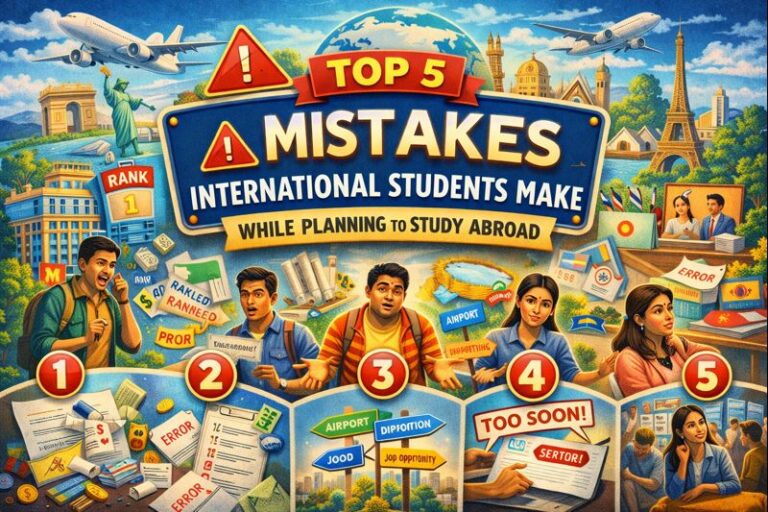If you are reading this article, you are all set to go abroad. You have secured funding and received a student visa. There is one more step before you depart. You must get a credit card. Handling cash can be a hassle for students. It is unsafe to carry large amounts of cash, and the rest of the world does not use an easy and convenient payment interface such as UPI.
There are hundreds of credit cards available in India. Every major bank offers several types of credit cards. With so many options available, how do you pick the best credit card that suits your needs? This guide will help explore the best credit card for international students and what features to look for. Let’s begin.
Why international students need a credit card
As an international student, you have to manage your finances alone. From grocery shopping to booking flights, a credit card makes everyday transactions simpler and more secure.
Here are a few reasons why an international student credit card is a must-have:
Universal Acceptance
Visa and Mastercard, the main issuers of credit cards, together handled more than 120 billion transactions worldwide in 2024. This huge volume dwarfs local debit networks. You can pay using a credit card at almost any merchant or order online without carrying large sums of cash.
Lower Hidden Costs
Most cards for international students let you pay in the local currency without a forex markup. For example, RBL World Safari has a 0 % FX fee. This means you avoid the 3 %–4 % currency conversion surcharge that many POS terminals silently add.
Emergency Credit Line
If your stipend or remittance is delayed, a credit card can cover rent and essential expenses while you wait. This is something a prepaid forex card cannot do.
Builds Credit History
Regular, on-time repayments are reported to Indian credit bureaus. When you take a local student card later, it is reported to the bureaus abroad as well. That record helps you qualify for cheaper loans and mortgages.
Perks That Beat Forex Cards
A Niyo Global debit card gives zero FX mark-up, but it offers no interest-free period or rewards. Travel-oriented student credit cards bundle offer reward points, lounge access at the airport, complimentary travel insurance, and concierge support. This adds plenty of value at no extra cost if you clear dues in full.
Factors to consider when choosing a credit card
Choosing the best credit card for international students isn’t just about reward points and offers. It’s about selecting a card that matches your spending habits, financial needs, and eligibility. Here are the top features to evaluate before you apply:
Cost & Acceptance
Foreign-transaction mark-up
Anything above 2% eats into your budget. Many issuers still charge the standard 3.5%, so prioritise cards such as RBL World Safari or IDFC FIRST WOW! With 0% forex conversion markup.
Annual fee vs waiver
Would you like to pay an annual fee or opt for a free card? A ₹3,000 fee is acceptable if the card waives it on moderate spending or offers lounge passes. Cards with an annual fee also offer more reward points.
Dynamic Currency Conversion
Always choose a card that lets you pay in the local currency. DCC adds another 1%–3% on top of the card’s own FX fee.
Network reach
Visa and Mastercard have the biggest reach. Narrower networks (AmEx, Diners) can be hit-or-miss for groceries and public-transport kiosks.
Value & Credit-Building
Look for high rewards
Some cards now give 5 Travel Points per ₹100 on airlines or hotels and 2 points on everything else. This allows you to earn while you spend.
Grace period and interest rate
Check that you get at least 45 interest-free days and a manageable interest rate. Many cards charge upwards of 35% interest annually.
Reporting to bureaus abroad
Some student cards report to Equifax, Experian, and TransUnion. These are credit agencies abroad that help jump-start your FICO score.
Eligibility & Ease of Approval
No-income or low-income options
Banks like IDFC and RBL approve student cards with a fixed deposit or a parent’s co-signature. This makes it easy to obtain your first card.
Online KYC & documentation
You should be able to complete video-KYC with PAN, Aadhaar, and your admission letter. This reduces hassle and paperwork.
Best credit cards for international students
Finding the best credit card for international students from India can seem challenging. However, there are some great options available both in India and in destination countries like the USA, Canada, the UK, and Australia. We share some of the top credit cards for international students with little or no credit history.
The table below shows the six best credit cards Indian students most often pick. The first three are issued from India. You can sign up for the other three when you have a Social Security number (SSN) or Individual Taxpayer Identification Number (ITIN).
| Card | Where you apply | FX markup / foreign-txn fee | Annual fee | Eligibility snapshot | Why pick it? |
| RBL Bank World Safari | India (online or branch) | 0 % | ₹3,000 + GST (waived on ₹3 lakh yearly spend) | Age ≥18, Indian address, income or FD back-up | Saves 3–3.5 % on every overseas swipe; 5 Travel Pts/₹100 on travel; free travel insurance |
| IDFC FIRST WOW! | India | 0 % | ₹0 | Secured against a ≥₹20,000 FD (great if you have thin credit history) | No-fee, Visa Infinite privileges, interest-free ATM cash for 45 days |
| HDFC Regalia Gold + Global Value | India | 2 % | ₹2,500 + GST (waived on ₹3 lakh spend) | Indian proof of income or parent co-applicant | Lower FX than typical 3.5 %, Priority Pass lounges, decent airline miles |
| Bank of America Travel Rewards Student | USA (SSN/ITIN) | 0 % | $0 | US address + SSN/ITIN; F-1 or J-1 visa | 1.5 pts/$ on everything, 25 k-point welcome bonus, reports to all U.S. bureaus |
| Capital One Quicksilver Student | USA | 0 % | $0 | SSN/ITIN; can apply six months after opening a US bank account | Flat 1.5 % cash back; no expiry; automatic credit-line reviews |
| Deserve EDU Mastercard | USA | 0 % | $0 | Passport + student visa + I-20; no SSN needed | 1 % cash back, 1-yr Amazon Prime Student credit, reports to bureaus |
How to apply for a credit card as an international student
Many students wonder how exactly they can apply for a credit card for students. The process might vary slightly based on the bank, but the steps are largely similar.
Here’s a simple, step-by-step guide to help you apply successfully:
Applying in India (before departure)
| Step | What to do | Why it matters |
| 1 | Collect KYC documents: PAN, Aadhaar, valid passport, admission letter/I-20/CAS | Banks must verify identity and study purpose under RBI rules |
| 2 | Choose unsecured vs secured: If you lack income history, open a fixed deposit (at least ₹20,000–₹25,000) and request a secured card like IDFC WOW! | Guarantees approval, keeps interest costs low |
| 3 | Complete video-KYC on the bank app | Saves you an extra branch visit when you’re busy with visa paperwork |
| 4 | Activate international usage in net-banking** before you board** | By default, most issuers keep overseas swipes off for fraud control |
Applying after arrival (destination country)
| Track | Typical documents | Quick tips |
| With SSN (e.g., after getting an on-campus job) | SSN, U.S. address proof, passport, I-94 | Cards like BofA Travel Rewards Student approve thin files if you hold a local bank account for ≥3 months |
| With ITIN | Passport & visa, W-7 ITIN application receipt | Many issuers (Capital One, Discover) accept ITINs instead of SSNs |
| No SSN/ITIN | Passport, I-20, U.S. phone & address | Fin-tech cards such as Deserve EDU or Zolve use alternative underwriting |
| Become an authorised user | Friendly roommate/relative adds you to their card | Their on-time payments start building your own US credit file in <60 days |
Getting the best credit card for international students is easier than you think. With the right approach and little planning, you will soon be swiping with confidence.
Credit card usage tips for international students
A credit card offers plenty of benefits. It is accepted everywhere and lets you conduct forex transactions with no effort. But misuse can lead to huge debt, while smart usage can open doors to future credit and better loans.
Here are essential tips for getting the most out of your international student credit card:
- Pay in full, on time. Set an AutoPay mandate from your Indian (or US) bank so you never miss the due date and avoid ≥35 % interest.
- Always choose the local currency at shops or ATMs to dodge dynamic currency conversion (DCC) mark-ups of 3%–4 %
- Turn on two-factor authentication (OTP + PIN or biometrics). RBI now requires AFA for most cross-border online transactions.
- Track spends under the RBI LRS cap ($250,000 per financial year). Your card statement shows outward remittances that count toward the limit.
- Avoid cash advances unless you need them urgently. Even zero-markup cards charge instant 22%–40% APR plus huge flat fees.
- Review your statement in both INR and host currency to spot double conversions or fraudulent charges early.
- Plan an upgrade path. Use the card for the first 9–12 months and clear payments. You can then request a higher limit or shift to a premium card.
- Keep Indian and foreign cards active. A small ₹500 bill payment every few months on your Indian card keeps that domestic credit score alive while you build credit overseas.
By following these credit card usage tips, you can enjoy the benefits of credit cards for international students without falling into debt.
Frequently Asked Questions
1. What is the best credit card for international students?
If you are leaving soon and want zero FX pain, start with World Safari or IDFC WOW!
Once you are in the US with an ITIN or SSN, BofA Travel Rewards Student is the easiest long-term builder.
2. How can I apply for a credit card as an international student?
It is easy to apply for a credit card in India. You can apply from the bank website. There will be a callback. After you have filled up an application form, there will be eKYC using your smartphone or laptop.
If you are in the USA, most banks need you to have an SSN (Social Security Number) or an ITIN (Individual Taxpayer Identification Number). Some banks, however, have more relaxed norms, such as BofA Travel Rewards Student. It is difficult to get a local card in countries like the UK, where you need to stay longer before you can apply for a credit card.
It is best to take a credit card issued in India abroad and then apply as per local norms.
5. Are there credit cards with no annual fees for international students?
IDFC FIRST WOW! is the best credit card with no joining or annual fee. You can also choose from IndusInd Bank Platinum Aura Edge Credit Card and ICICI Coral, but they will charge about 3.5% forex fee.
6. How do I build my credit history as an international student?
To build your credit score with a credit card, the key is to use it responsibly. This means paying your bills on time, keeping your credit utilization low, and using the card regularly for small purchases.
7. What are the benefits of using a credit card as an international student?
Using a credit card as a student abroad provides several benefits. These include –
- Building credit history
- Having access to emergency funds
- Convenient payment options















